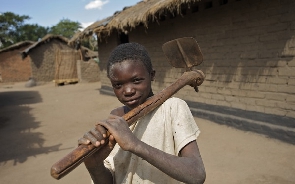On the streets of Ghana, it is very common to come across lots of children engaged in various forms of labour to earn a living but without any form of proper guidance.
This is contrary to Section 89 of the Children’s ACT 1998 (560), which states that the “minimum age for admission of a child to employment shall be 15 years.” In addition to this, strict supervision must be enforced in order not to result in child labour.
Apart from children who openly sell along the streets, what has added to the national burden in recent times is a new group of youngsters who carry very sharp tools such as cutlasses, hoes, and sometimes axes looking for portions of land to clear for a fee. They often end up securing no work by the close of the day, and in such an awkward situation, they become dangerous to society.
This is because, when they are left with no option, they turn to beg for alms from passers-by which is usually delivered in pittance.
But the big question is … what about the tools they carry? A wrong mindset borne out of anger and hunger can convert these harmless tools into dangerous weapons and force them to do the unthinkable. Innocent law-abiding citizens are therefore susceptible to an imminent attack since giving alms on the street is a choice most people refuse to give in to.
This is something the authorities have to think about seriously because they pose a lot of security risk. Also in the neighbourhoods is another disturbing scene of children carrying surgical tools like medical doctors, who move about to cut and trim nails as if they have been granted a license to do pedicures.
The most bizarre aspect of it all is that they use the same tools over and over again in servicing their clients while moving from one person to the other without any regard for its health implications. The question therefore arises: What if our innocent children are spreading diseases unknowingly through their activities?
They indeed have a huge market but the truth is both clients and service providers are exposed to a lot of dangers. According to a renowned medical practitioner, Peter Paul Akagwire, “City authorities need to sanitise the commercial nail-cutting tools. He affirms that the practice is unhygienic since the same instrument is used to serve many customers without adequate disinfection or sterilization.” Both children and clients are therefore exposed to diseases such as HIV/AIDS, Hepatitis B and C, and other skin infections.
In most neighbourhoods’ residents are daily bombarded with high-pitched chants of, “condemn! condemn! by some strange youth scavenging for everything metal or parts of discarded electronic parts known commonly as e-waste. Strangely, these aggressive youth seem to be very familiar with all the nooks and crannies of the places they ply their trade even though they may appear to be strangers.
In their forays, they are like magnets attracted to everything metal. There have been reports about some of these metal scavengers resorting to thievery and ending up being beaten to a pulp.
Many scenarios like the few listed have become daily occurrences in both the big and small towns in Ghana. But children being at the centre makes the situation more disturbing. This is because they reflect the daily emotional and physical challenges affecting victims of child labour which does not augur well for their proper nurturing and growth.
But the question begging for an answer is: Who is going to speak for them by way of helping to regulate their activities even if they cannot totally be prevented from engaging in child labour and perhaps be provided with the opportunity to get educated?
The government’s effort to rope all children into the classroom through its various programs and policies is very laudable. However, while a significant number of children benefit from these initiatives, it has to be acknowledged that several others are still wasting away on the streets.
Authorities at the local level must therefore complement the efforts of the central government by assisting these children with opportunities that would help them gain access to school.
From the observers stand point, the realities on the streets paint a gloomy picture of the future of Ghana where several children who should have been in the classroom are rather exposed to the harsh conditions of street life. The school should have served as their safe haven but unfortunately. the street has become an irresistible alternative unleashing untold hardship on our children.
Digging deep to establish why some children resort to being on the streets to work at that tender age, it becomes obvious that the root cause is basically, poverty and weak institutions to make the law work effectively. It is pertinent therefore to suggest to the government to strengthen its collaboration with local NGOs who are working with communities to find a common ground to address the challenges robbing children of a brighter future.
The clarion call should be, “No child must be left behind in the search for education.” Every child needs to be educated. This is the hope for Ghana.
Opinions of Tuesday, 21 November 2023
Columnist: Yaw Anakwah



















